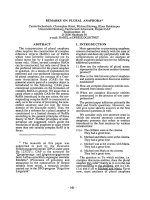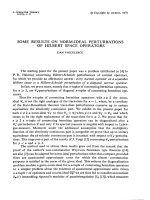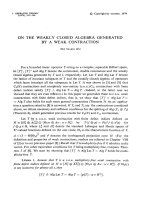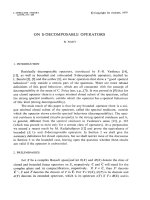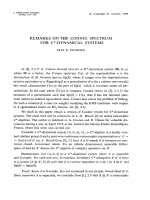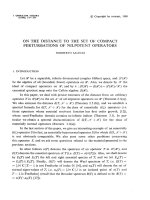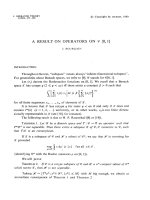Báo cáo toán học: "Queens on Non-square Tori" pptx
Bạn đang xem bản rút gọn của tài liệu. Xem và tải ngay bản đầy đủ của tài liệu tại đây (61.44 KB, 3 trang )
Queens on Non-square Tori
Grant Cairns
Department of Mathematics
La Trobe University, Melbourne, Australia 3086
Submitted: January 29, 2001; Accepted: June 11, 2001.
MR Subject Classifications: 05C69, 05B99
Abstract
We prove that for m<n, the maximum number of nonattacking queens that
can be placed on the n × m rectangular toroidal chessboard is gcd(m, n), except in
the case m =3,n =6.
The classical n-queens problem is to place n queens on the n×n chessboardsuchthat
no pair is attacking each other. Solutions for this problem exist for all for n =2, 3[1].
The queens problem on a rectangular board is of little interest; on the n × m board for
m<n, one can obviously place at most m nonattacking queens and for 4 ≤ m<n,one
can just take a solution on the m × m board and extend the board. Moreover, the reader
will easily find solutions on the 3 × 2and4× 3 boards and so these give solutions on the
n × 2andn × 3 boards for all 3 ≤ n and 4 ≤ n respectively.
In chess on a torus, one identifies the left and right edges and the top and bottom edges
of the board. On the n × n toroidal board, the n-queens problem has solutions when n is
not divisible by 2 or 3 [3], and the problem of placing the maximum number of queens when
n is divisible by 2 or 3 is completely solved in [2]. The traditional n-queens problem and
the toroidal n-queens problem are closely related, both logically and historically (see [4]).
However, unlike the rectangular traditional board, the queens problem on the rectangular
toroidal board is interesting and non-trivial and yet it seems that it has not been studied.
In order to work on the toroidal board we use the ring
i
= /(i), which we identify
with {0, ,i− 1}, and the natural ring epimorphism
→
i
; x → [x]
i
,where[x]
i
is
to be interpreted as the remainder of x on division by i. We give the squares of the
n × m toroidal board coordinate labels (x, y), x ∈
m
,y ∈
n
, in the obvious way.
The positive (resp. negative) diagonal is the subgroup P = {([x]
m
, [x]
n
); x ∈ } (resp.
N = {([x]
m
, [−x]
n
); x ∈ }). Notice that the diagonals are both subgroups of
m
×
n
of index gcd(m, n ). In addition, there is the vertical subgroup V = {(0, [x]
n
); x ∈ }
which has index m, and the horizontal subgroup H = {([x]
m
, 0) ; x ∈ } which has index
n. Queens at distinct positions (x
1
,y
1
), (x
2
,y
2
) are nonattacking if and only if (x
1
,y
1
)
the electronic journal of combinatorics 8 (2001), #N6 1
and (x
2
,y
2
)belongtodistinctcosetsofV, H,P and N. In particular, the n × m toroidal
board can support no more than gcd(m, n) nonattacking queens.
The aim of this paper is to prove the
Theorem. For m<n, the maximum number of nonattacking queens that can be placed
on the n×m rectangular toroidal chessboard is gcd(m, n), except in the case m =3,n=6.
Proof. First let d =gcd(m, n) and suppose that d = 3. Notice that in order to place d
nonattacking queens on the n×m toroidal board, it suffices to place d nonattacking queens
on the 2d×d toroidal board. Indeed, although the natural injection
d
×
2d
→
m
×
n
is
not in general a group homomorphism, it is easy to see that if two queens are nonattacking
in
d
×
2d
, their images in
m
×
n
are also nonattacking. Thus, without loss of generality,
we may assume that n =2m.Inthiscasegcd(m, n)=m.
If m ≡ 1, 2, 4, 5 (mod 6), a solution is easily obtained by placing a queen at each point
in the set A = {(i, 2i); i ∈
m
}. Indeed, it is clear that no two distinct elements of A
belong to the same coset of H or V .Ifelements(i, 2i)and(j, 2j)belongtothesame
coset of P,theni − j ≡ 2i − 2j (mod m)andsoi ≡ j (mod m) which implies i = j.If
elements (i, 2i)and(j, 2j)belongtothesamecosetofN, then one has 3i ≡ 3j (mod m)
which also gives i = j when m is not divisible by 3.
Now suppose that m is divisible by 6, say m =2
k
.6.l,wherel is odd. Here the situation
is slightly more complicated; a solution is obtained by placing queens at positions (i, f (i)),
for i =0, ,m− 1, where
f(i)=
2i +[i]
6l
;if [i]
3l
=[i]
6l
,
2i +1+[i]
6l
; otherwise.
The case where m ≡ 3 (mod 6) is a good deal more complicated; we consider two subcases.
First if m ≡ 3 (mod 12), say m =12k + 3, a solution is obtained by placing queens at
positions (i, g(i)), for i =0, ,m− 1, where
g(i)=
3i ;if i ≤ 4k,
2;ifi =4k +1,
2+m ;if i =4k +3,
3i − m +4 ;if4k +2≤ i ≤ 10k and i is even,
3i − m +2 ;ifi =10k +2,
3i − m − 4;if4k +5≤ i ≤ 10k +3andi is odd,
3i − m ;if i ≥ 10k +4.
On the other hand, if m ≡ 9 (mod 12), say m =12k + 9, a solution is obtained by placing
the electronic journal of combinatorics 8 (2001), #N6 2
queens at positions (i, h(i)), for i =0, ,m− 1, where
h(i)=
3i ;if i ≤ 4k +2,
2;ifi =4k +3,
2+m ;if i =4k +5,
3i − m +4 ;if4k +4≤ i ≤ 10k +6andi is even,
3i − 2m − 2;ifi =10k +8,
3i − m − 4;if4k +7≤ i ≤ 10k +7andi is odd,
3i − m ;if i ≥ 10k +9.
The verification that the above functions f,g and h have the required properties is tedious
but elementary.
It remains to deal with the case where gcd(m, n) = 3. Here the reader will readily find
that there is no solution on the 6 × 3 board, but there are solutions on the 9 × 3 board.
It follows that there are solutions on the n × m board for all m<nwith gcd(m, n)=3
except in the case m =3,n= 6. This completes the proof of the theorem.
References
[1] W. Ahrens, Mathematische Unterhaltungen und Spiele, B.G. Teubner, 1921.
[2] P. Monsky, Problem E3162, Amer. Math. Monthly 96 (1989), 258–259.
[3] G. P
´
olya,
¨
Uber die “ doppelt-periodischen” L¨osungen des n-Damen-Problems, George
P´olya: Collected papers Vol. IV (G C. Rota, ed.), pages 237–247, MIT Press, Cambridge,
London, 1984.
[4] I. Rivin, I. Vardi and P. Zimmermann,Then-queens problem, Amer. Math. Monthly
101 (1994), 629–639.
the electronic journal of combinatorics 8 (2001), #N6 3
